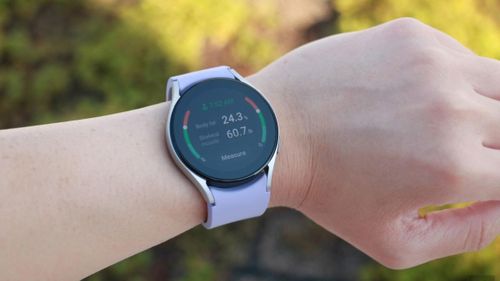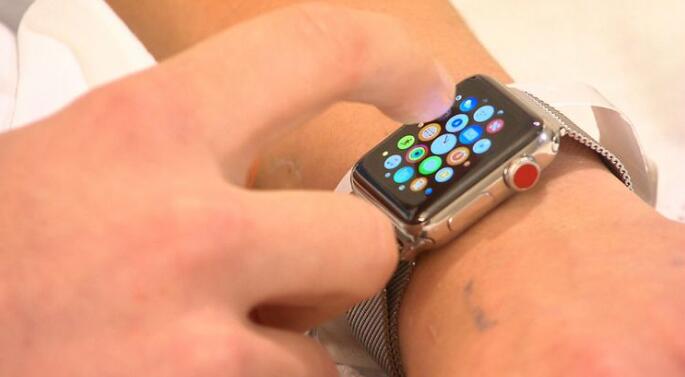When Ricki-lee Wynne turned 40, her husband gave her a Samsung smartwatch for her birthday.
The Melbourne mum-of-four believes that without that gift, she would not be here today.
“There’s no doubt that my smartwatch saved my life,” she told 9news.com.au.
READ MORE: Aussie families save on groceries by foraging for food

Wynne had been having some strange health problems in the months before she was given the watch.
“I was getting a pain over my shoulder blades and it hurt each time I breathed in,” Wynne said.
Doctors were puzzled and Wynne was in and out of hospital having X-rays, scans and blood tests in a bid to get to the bottom of what was wrong.
Wynne also had an echocardiogram at the time, to test the functioning of her heart – all appeared normal.
“The doctors were not sure what it was. They thought it could be a low-grade blood cancer,” she said.
The pain went away for a few months, but – in February 2021 – Wynne’s breathing problems returned.
“I woke up one day and I couldn’t breathe properly. I was just walking into work and I was thinking, ‘Gosh, I can’t get enough air into my lungs,'” Wynne said.
“I couldn’t walk from one side of the room to the other without being short of breath.
“I went to my GP and had an x-ray done, but nothing showed up.”
READ MORE: TikTok ban looms for Australian government phones

That’s when Wynne noticed her smartwatch was playing up.
“I’d been struggling with my watch for days to try and get the heart rate to show up,” she said.
Wynne previously had no problems getting the watch to read her heart rate – but now it just wasn’t picking it up.
“It was saying you need to change the position to measure a pulse,” she said.
“My chest was also feeling kind of wobbly for a couple of nights when I went to bed.”
Wynne said she went back to see her GP and told him she was worried something was really wrong, even though her X-ray was clear.
“I just said to him, ‘Even my heart rate isn’t right, look at my watch,’ and I showed it to him.”
Wynne’s GP ordered an electrocardiogram (ECG), which showed that her heart rate had dropped to an alarming 29 beats per minute.
“As soon as I had the ECG, I had the doctor call me back and say you need to go straight to Box Hill Hospital,” Wynne said.
“I was told at the hospital that if I hadn’t come in I would have just died in my sleep.
“I would not have woken up and my heart would have stopped.”
Wynne was fitted with an emergency pacemaker and eventually diagnosed with a rare auto-immune condition called sarcoidosis.
Sarcoidosis causes inflammation in different parts of the body, most commonly the lungs.
During flare-ups, the inflammation can spread from one organ to another.
Doctors believe Wynne’s sarcoidosis moved from her lungs to her heart, causing her to become dangerously ill.
Wynne still has the pacemaker in, and the device – combined with medication – has allowed her health to improve significantly.
‘Fitbits are saving women’s lives’
Smartwatches have become ubiquitous and stories like Wynne’s – of the devices picking up undiagnosed health problems – are becoming more common as the heath technology on offer improves.

Earlier this month, Australian parenting expert and commentator Maggie Dent shared her experience of ending up in an emergency department after her heart rate – shown on her Fitbit – shot up from 64 to 145 beats per minute.
“When I noticed my Fitbit showed my heart rate I thought it must be malfunctioning,” Dent wrote on Facebook.
Dent was diagnosed with a heart flutter, which can increase the risk of stroke or heart failure, and said the data provided by her Fitbit had helped with developing her treatment plan.
“It seems I may have saved my life. One emergency nurse told me that Fitbits are saving women’s lives as they often have no symptoms like me,” Dent wrote.
Smartwatch-led diagnoses pose new challenges
Victor Chang Cardiac Research Institute executive director Professor Jason Kovacic said patients were coming to him with potential heart problems picked up on smartwatches.
“I definitely have had a few patients come to me, or be referred to me, with abnormal findings on a smartwatch, and then we go on to try to validate or verify that using various techniques,” Kovacic, who is a cardiologist at Sydney’s St Vincent’s Hospital, said.
But while health technologies offered by smartwatches were exciting and improving rapidly, the reality was that undetected heart problems in the general population were relatively rare, Kovacic added.

A recent study published in the American Heart Association Journal in September last year tracked more than 455,000 participants, who each wore a Fitbit watch for a week.
An irregular heart rhythm was detected in about 1 per cent of participants.
A follow-up ECG confirmed a diagnosis of an irregular heart rhythm in about a third of those cases.
A similar 2019 study using an Apple Watch, published in the New England Journal of Medicine, detected an abnormal heart rhythm in 0.5 per cent of more than 400,000 participants.
Like the Fitbit study, follow-up ECGs confirmed atrial fibrillation in around a third of cases.
Contact reporter Emily McPherson at [email protected].
Diagnoses of atrial fibrillation picked up by smartwatches were posing new challenges for cardiologists such as himself, Kovacic said.
Treatment plans for patients who presented to emergency departments with strong symptoms were clear and well established, he said.
This was not the case for patients with no symptoms, where a smartwatch had picked up an abnormal rhythm they would never have otherwise known about, he said.
“We don’t know what the optimal management of that patient is, and if we do all the stuff that we normally do for atrial fibrillation, that may be overtreating them,” he said.
“Maybe we need to be a lighter touch with these people.
“Maybe they don’t need all the drugs that we would normally use.
“Maybe they need nothing, we don’t know.
“We don’t have that data. So there’s some clinical trials that need to be done to look at if you detect atrial fibrillation with a smartwatch, what’s the appropriate course of management?”
Kovacic, who wears a smartwatch himself to monitor his health, said there was no doubt that wearable devices were providing valuable information, and could not only detect some abnormal rhythms but also significant other health problems, such as sleep apnoea.
“Once we understand how to use the data, we’re going to see that this is going to become a way of the future,” he said.
“We have these devices we wear that tell us all sorts of information about how we’re performing and how we’re exercising and sleeping and our overall heart health – it’s really exciting.”



